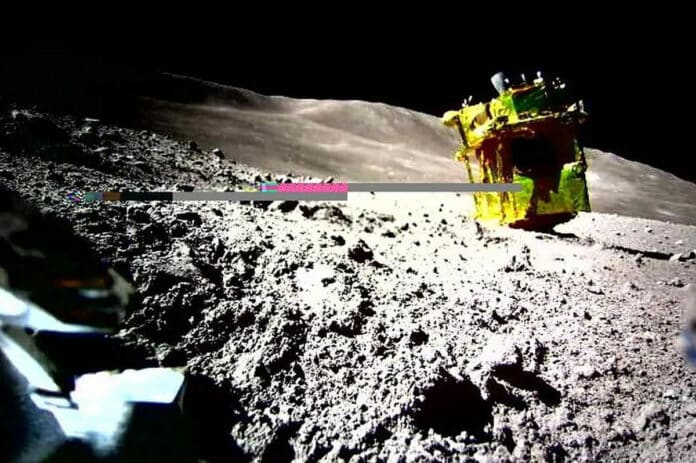On January 20, 2024, the Japan Aerospace Exploration Agency (JAXA) announced that the Lunar Excursion Vehicle (LEV-1), a small robot deployed from the Smart Lander for Investigating Moon (SLIM), successfully conducted activities on the lunar surface. The small robot sent telemetry data directly to the ground stations.
The telemetry data showed that LEV-1 executed planned leaping movements and direct communication with ground stations, including inter-robot test radio wave data transmission from the Transformable Lunar Robot (LEV-2, nicknamed “SORA-Q”). The images returned by the robots show the spacecraft is sitting on its nose, preventing its solar panels from charging.
On January 19, 2024, JAXA’s SLIM spacecraft touched down on the Moon in a precision landing, making Japan the fifth country to make a soft landing on the lunar surface after India, China, the United States, and Russia (then the Soviet Union). The lander was in good shape, and everything worked as planned, but the solar panels failed to charge the battery. This meant that SLIM had only a few hours of power left.
To save the mission, JAXA engineers ordered the lander to go into sleep mode while they tried to fix the issue. Luckily, SLIM had already deployed two small rovers named Lunar Excursion Vehicle 1 (LEV-1) and Sora-Q (LEV-2) before touching down.
The small baseball-sized Sora-Q has a camera aboard, which it uses to take images of the landing area and SLIM and then relay them back to Mission Control using LEV-1.
LEV-1 has completed its planned operational period on the lunar surface, depleted its designated power, and is currently in a standby state on the lunar surface. However, there are still efforts to receive signals from the robot, and it is possible for it to resume activity if solar power generation occurs due to changes in the sun’s direction.
Both LEV-1 and LEV-2 have become Japan’s first lunar exploration robots. The small LEV-1, which has a mass of only 2.1 kg, including a communication device weighing 90g, achieved successful direct communication with Earth from the Moon. This is considered the world’s smallest and lightest case of direct data transmission from such a distance of approximately 380,000 kilometers.
According to JAXA, the accomplishment of LEV-1’s leaping movements on the lunar surface, inter-robot communication between LEV-1 and LEV-2, and fully autonomous operations represent groundbreaking achievements. It would be regarded as a valuable technology demonstration for future lunar explorations, and the knowledge and experience acquired will be applied in upcoming missions.
Moreover, the transmission of UHF band radio waves from LEV-1 as part of outreach efforts has encouraged participation from amateur radio operators globally, and we have been receiving reports of successful signal receptions. This initiative provided an opportunity for the public to be directly engaged in lunar exploration missions. We would like to extend our sincere gratitude to everyone involved in the LEV-1 mission.
